Click on images to enlarge
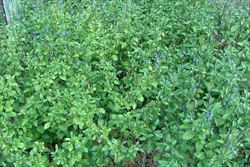
infestation (Photo: Sheldon Navie)
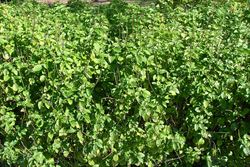
infestation (Photo: Sheldon Navie)

habit (Photo: Sheldon Navie)
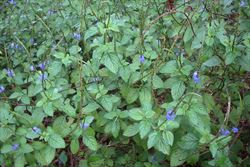
habit (Photo: Sheldon Navie)

paired leaves with toothed margins (Photo: Sheldon Navie)

elongated flower clusters (Photo: Sheldon Navie)

flowers (Photo: Sheldon Navie)
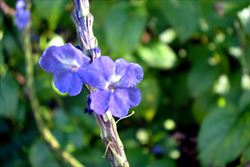
close-up of flowers (Photo: Sheldon Navie)

young seedlings (Photo: Sheldon Navie)

seedling (Photo: Sheldon Navie)
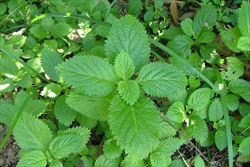
young plants (Photo: Sheldon Navie)
Scientific Name
Stachytarpheta cayennensis (Rich.) Vahl
Synonyms
Verbena cayennensis Rich.Stachytarpheta dichotoma (Ruiz Lopez & Pavon) Vahl (misapplied)Stachytarpheta urticaefolia (Salisb.) SimsStachytarpheta urticifolia (Salisb.) Sims
Family
Verbenaceae
Common Names
blue porter weed, blue porterweed, blue rat's tail, blue snake-weed, blue snakeweed, bluetop, Cayenne snakeweed, dark blue snake weed, dark blue snake-weed, dark blue snakeweed, false verbena, nettleleaf velvetberry, nettleleaf vervain, rattail, rough leaved false vervain, rough-leaf false vervain, rough-leaved false vervain, snake weed, snake-weed, snakeweed
Origin
Native to Mexico, Central America (i.e. Belize, Costa Rica, El Salvador, Guatemala, Honduras, Nicaragua and Panama), the Caribbean, tropical South America (i.e. French Guiana, Guyana, Surinam, Venezuela, Brazil, Colombia, Ecuador, Peru and Argentina) and the Galapagos Islands.
Cultivation
Dark blue snakeweed (Stachytarpheta cayennensis) is often cultivated as a garden ornamental, particularly in the warmer parts of Australia.
Naturalised Distribution
This species is becoming widely naturalised in the northern and eastern parts of Australia. It is most common in the coastal districts of the Northern Territory and northern Queensland. Also present in the coastal districts of central and southern Queensland, and in the northern parts of Western Australia.
Also naturalised in tropical Africa, Madagascar, tropical Asia (i.e. the Philippines, Malaysia, Taiwan and Papua New Guinea), the Mascarenes (i.e. the Seychelles and La Réunion), south-eastern USA (i.e. Florida) and Oceania (i.e. the Cook Islands, Fiji, French Polynesia, Guam, Kiribati, the Marshall Islands, Nauru, Niue, New Caledonia, Palau, the Solomon Islands, Western Samoa, Tonga and Hawaii).
Habitat
A weed of forests and forest margins, native bushland, roadsides, disturbed sites, waste areas, waterways, gardens, plantation crops and pastures in tropical and sub-tropical regions.
Habit
A small, long-lived (i.e. perennial), shrub usually growing 1-1.5 m tall, but occasionally reaching up to 2.5 m in height.
Distinguishing Features
- a small, long-lived, shrub with a woody rootstock that grows 1-2.5 m tall.
- its stems are four-angled when young and its leaves are oppositely arranged.
- its stems and leaves are mostly hairless and its leaves have a wrinkled texture and sharply toothed margins.
- its dark blue, purple, or violet flowers are arranged on long, curved, slender spikes at the top of the branches.
- these flowers are tubular in shape with five broad petal lobes (about 5 mm across).
Stems and Leaves
Younger stems are greenish or purple-tinged, mostly hairless (i.e. glabrous) except for a few hairs near the joints (i.e. nodes), and somewhat square in cross-section (i.e. quadrangular). These branched stems (up to 6 mm thick) tend to become rounded, light brown in colour, and somewhat woody as they mature.
The oppositely arranged bright green leaves (1.5-10 cm long and 1-5 cm wide) are borne on stalks (i.e. petioles) 5-30 mm long. They are somewhat glossy in appearance and either egg-shaped in outline (i.e. ovate) or oval (i.e. elliptic) in shape with pointed tips (i.e. acute apices). These leaves are hairless (i.e. glabrous) or have a few hairs along the veins on their undersides (i.e. sparsely strigose). Because they have sharply toothed (i.e. serrate) margins and a quite wrinkled (i.e. rugose) surface texture, they resemble "nettle" leaves.
Flowers and Fruit
Numerous small flowers are arranged on long, curved, slender spikes (10-45 cm long and 1-3 mm thick) at the top of the branches (i.e. in terminal spikes). These flowers are stalkless (i.e. sessile) and are usually dark blue, purple, or violet in colour. They are tubular in shape (6-8 mm long), with a slender tube and five broad petal lobes (about 5 mm across). Each flower also have five sepals (4-7 mm long), that are fused together for most of their length (i.e. into a calyx tube), and two fully developed stamens. Only a small number of these flowers are open at any one time, and each is subtended by a persistent, small, green bract (3-7 mm long and 1-2 mm wide) with a pointed tip (i.e. acuminate apex). Flowering occurs throughout the year, but is most abundant during spring, summer and autumn.
The small oblong fruit (3-6 mm long and 1.5-2 mm wide) are somewhat flattened (i.e. compressed) and hairless (i.e. glabrous). These fruit (i.e. schizocarps) turn dark brown to black in colour and split into two one-seeded structures (i.e. mericarps) at maturity.
Reproduction and Dispersal
Reproduction is almost entirely by seed.
These seeds are most commonly spread in dumped garden waste, soil, and contaminated agricultural produce. They may also become attached to animals, clothing, vehicles and machinery.
Environmental Impact
Dark blue snakeweed (Stachytarpheta cayennensis) is regarded as an environmental weed in the Northern Territory, Queensland and Western Australia.
Legislation
This species is declared under legislation in the following states and territories:
- New South Wales: Class 5 - a restricted weed which must not be sold, bought or knowingly distributed (throughout the entire state).
- Northern Territory: B - spread to be controlled (throughout all of the Territory), and C - not to be introduced to the Territory. This legislation applies to all snakeweed species (i.e. Stachytarpheta spp.).
- Western Australia: Unassessed - this species is declared in other states or territories and is prohibited until assessed via a weed risk assessment (throughout the entire state).
Management
For information on the management of this species see the following resources:
- the Biosecurity Queensland Fact Sheet on snakeweeds, which is available online at http://www.dpi.qld.gov.au.
- the Northern Territory Department of Natural Resources, Environment and The Arts Agnote on snakeweeds, which is available online at http://www.nt.gov.au/weeds.
Similar Species
Dark blue snakeweed (Stachytarpheta cayennensis) is very similar to light blue snakeweed (Stachytarpheta jamaicensis), white snakeweed (Stachytarpheta australis) and pink snakeweed (Stachytarpheta mutabilis). These species can be distinguished by the following differences:
- dark blue snakeweed (Stachytarpheta cayennensis) has dark blue, purple, or violet flowers (about 5 mm across) that are borne on slender flower spikes (1-3 mm thick). Its stems and leaves are almost or totally hairless (i.e. glabrous), and its leaves have a wrinkled appearance with sharply, and deeply, toothed (i.e. serrated) margins.
- light blue snakeweed (Stachytarpheta jamaicensis) has pale blue, blue or mauve flowers (about 8 mm across) that are borne on relatively robust flower spikes (3-5 mm thick). Its stems and leaves are almost or totally hairless (i.e. glabrous), and its leaves are slightly fleshy in nature with sharply, but finely, toothed (i.e. serrated) margins.
- white snakeweed (Stachytarpheta australis) has pale blue or almost white flowers (about 5 mm across) that are borne on relatively robust flower spikes (about 3-5 mm thick). Its stems and lower leaf surfaces are hairy (i.e. pubescent), and its leaves have a somewhat wrinkled appearance with sharply toothed (i.e. serrated) margins.
- pink snakeweed (Stachytarpheta mutabilis) has relatively large pink to reddish flowers (10-12 mm across) that are borne on robust flower spikes (up to 7 mm thick). Its stems and both leaf surfaces are densely covered in hairs (i.e. pubescent), and its leaves are velvety in texture with sharply, but finely, toothed (i.e. serrated) margins.
Dark blue snakeweed (Stachytarpheta cayennensis) also hybridises with other species, and hybrids between it and both light blue snakeweed (Stachytarpheta jamaicensis) and pink snakeweed (Stachytarpheta mutabilis) have also become naturalised in Queensland. These hybrids exhibit characters that are intermediate between the two species involved.
It is also relatively similar to the common verbenas (Verbena litoralis and Verbena officinalis). However, the common verbenas (Verbena litoralis and Verbena officinalis) can be distinguished from dark blue snakeweed (Stachytarpheta cayennensis) by having four fully developed stamens (instead of two) and smaller flowers that are less than 4 mm across.

